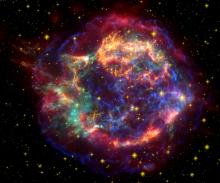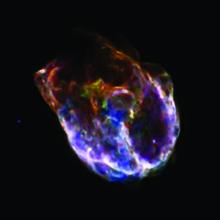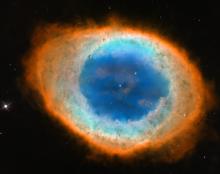Listen to today's episode of StarDate on the web the same day it airs in high-quality streaming audio without any extra ads or announcements. Choose a $8 one-month pass, or listen every day for a year for just $30.
You are here
Arneb
With every breath, you’re inhaling the “ash” from a nuclear furnace — nitrogen and oxygen created by a star. Many stars are making more of these elements today, and will someday expel them into space — perhaps to fill the skies of future planets.
One star that’s made a lot of nitrogen is Arneb, the leading light of the constellation Lepus, the hare. It’s in the southwest as night falls, below brilliant Orion.
Arneb is roughly 14 times the mass of the Sun. Such heavy stars “burn” through the hydrogen fuel in their cores in a hurry. They smash together the hydrogen to make helium. But they do it in a different way from stars like the Sun.
The Sun makes helium directly by fusing the nuclei of hydrogen atoms — bare protons. But stars like Arneb use a catalyst: carbon, which is present in small amounts when the star is born.
In a series of steps, the carbon fuses with hydrogen to make nitrogen, followed by a heavier form of carbon. This carbon then splits apart. That yields helium plus the type of carbon that started the whole thing. So hydrogen is converted to helium, while the carbon is still around to continue the process.
In Arneb, some of the nitrogen created in this sequence has survived. It’s mixed with the star’s outer layers. Arneb eventually will blast the nitrogen and other elements created inside the star out into space. That will seed the galaxy with the ingredients for new stars, planets — and planetary atmospheres.
Script by Damond Benningfield






